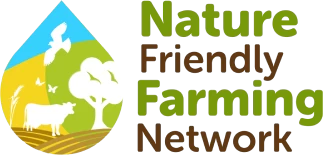Written by: Helen Keys, Steering Group member for Northern Ireland
“Helen Keys and Charlie Mallon, both members of the NFFN, farm 50 acres in Northern Ireland’s Moneymore. The farm was traditionally dairy then livestock, but in the last few years, they have diversified into flax, potatoes, oats and hemp.“
Northern Ireland used to be full of flax fields – ‘the wee blue blossom’ appeared in mid-summer to such an extent that people said it looked like the sky had fallen. The Irish Linen industry was one of the biggest employers and flax was a hugely profitable crop.
Talk to any of the older farmers in Northern Ireland and they will tell you they remember working the flax, especially the smell of the flax dam. Flax was retted in these dams – or ‘lint-holes’ – usually beside a river. This was one of the major issues with the industry, when the water was let away after retting, it had a toxic effect on nearby waterways.
This environmental issue, combined with the rise in cotton and synthetic textiles, was the death knell for the linen industry in Northern Ireland. But with an increasing demand for sustainable textiles and new technologies becoming available, could the blue blossom return?
For the last three years, we’ve grown flax while working with a growing community of people from all over the world who are interested in flax and linen. We quickly learned flax is an easy crop to grow. We planted seed from The Netherlands, and 100 days later, we had a lovely crop. No need for fertilisers or sprays, plus our bees loved it and we had flocks of linnets arrive.
Although simple to grow, it’s not so easy to harvest. We did it by hand with a lot of help from friends and neighbours and the odd stranger who just wanted to see what we were up to. The tradition was that five men could pull an acre in a day, while we haven’t managed that yet, we’re certainly getting better at it.
The retting is done in an upcycled cheese vat, and afterwards, we draw the water out with a slurry tank and use it as a low-cost fertiliser on the fields – an easy solution that most farms could implement.
The big challenge is in getting to the next stages so we can operate at a commercial and sustainable level, but we’ve discovered some pretty large gaps in the rest of the supply chain. Up until the 1950s, there were scutching, spinning, weaving and beetling mills all over the country. Now we have hand spinners, some weavers and just one beetler.
But with such a demand for homegrown flax, we’ve persevered with filling in the gaps. We were surprised to discover there was a market just for the raw stooks of flax from florists and interior designers, we’ve hand-processed some small quantities through to fibre which hand spinners are keen to buy.
We are just finishing the restoration of an old 1940s scutching turbine which will allow us to process much bigger quantities that can be handspun and woven into finished linen. We’re delighted to report that we have a lengthy waiting list for the linen – a sure sign of the growing demand for homegrown linen!
There is a move towards using flax and hemp to make composite materials to replace the use of plastics or building materials. Flax-based surfboards, furniture and musical instruments are in production and there is now a Natural Fibre Composites Collective in Northern Ireland. Demand for fibre crops is likely to increase as more of these products reach the market and we might see more of the ‘wee blue blossom’ returning to our fields.
I don’t doubt that this surge of interest in flax is driven by a growing awareness of issues in the textile industry around waste, welfare, water and energy use. The opportunity to move back to a nature-friendly crop – one which can be grown with no fertiliser or pesticide, can be processed using harvested rainwater and could potentially be entirely produced within a 30-mile radius – is very appealing.
Follow our journey through the growing world of flax here.


